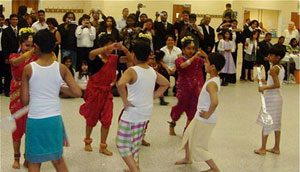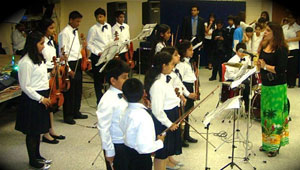| Swindon doesn’t look like a factory town. It is lush green with swathes of agricultural land, the streets lined with houses not given to prosperity but neither to the grime associated with industrial hubs. In the early part of the 21st century, Swindon became home to a substantial number of Goans who have made their way to the UK by virtue of a Portuguese passport.
 |
| Holy Rood Church where Goans congregate |
Much like the Biblical patriarch Abraham, Agnelo DeMello, the ex-President of the Goan Swindon Association, contends he is the genesis of the growing Goan tribe in Swindon. He moved here from the Gulf some twenty years ago. He knew the then manager of the Rover car assembly plant and was instrumental in getting jobs for Goans. From this humble seedling, a mighty tree has grown.
As per the 2001 UK Census, Swindon had a population of 180,061 of which 1.3% were Indian. Senior Catholic priest, Monsignor Twomey estimates the influx of Goans in recent years to be in the region of 8,000. This would probably make Swindon the city with the highest concentration of Goans anywhere in the world outside of Goa. The Monsignor notes that his largely Irish Catholic parish has now been replaced by Goans. A large percentage of them are from the Tiswadi Taluka in Goa, notably from Siridao, Goa Velha and Agassim. Portugal affords Goans, right to Portuguese nationality. Prior to the liberation of Goa in 1961, Goans were Portuguese nationals. This facility is still open to Goans born before 1961 and up to three generations thereof. With Portugal being a member of the European Union, holders of Portuguese passports can move freely within member states of the Union. One of the big draws of this mobility of labour, is Goans now have access to UK labour markets.
Swindon is an industrial estate, home to companies such as Honda, BMW and Faccenda, one of UK’s largest chicken processing plants. It is in factories such as these that Goans find employment. Inability of some to communicate fluently in English has been an impediment and condemned these to low-skilled jobs on the assembly line. In the spiralling 2007 recession, those hardest hit were the ones unable to speak in English confidently. Life is not only hard but competitive as well. Amongst native Swindonians, there is a feeling that an influx of immigrants including the Poles and Brazilians are taking over their jobs. In 2004, rocks were hurled at a coach carrying ethnic minority workers from Faccenda factory. Later in the year, coaches used to bus workers were vandalised. Faccenda, the chicken processing unit, which provided employment to at least 100 Goans, often came under attack for using cheap immigrant labour. Goans earn between £5.52 and £6.00 per hour. It’s difficult to make ends meet in the UK with a minimum-wage job.
Goans predominantly live in the town center along Manchester Road, Elmina Road and Broad Street. A major worry for any new arrival to the UK, is rent. A kudd-system, popular in Bombay, has been set up to ease the pain of initial rent payments. Families who arrived early on in Swindon invested in houses and have now converted parts of these houses into rooms for rent. The average monthly rent is between £350 to £400 per month. These cramped living conditions, have at times earned the ire of their neighbours. The large amounts of garbage generated and the resultant pestilence is seen as a health hazard. Doubtless, the entry of new immigrants is always viewed from a jaundiced perspective and a lot of problems that were already in existence in Swindon, are now likely to be blamed on the new entrants.
The Swindon migration is unique in one respect. These were not young men setting out to explore unknown worlds, as in Africa, the Gulf and even America. Many who emigrated to Swindon did so in their fifties, with full-fledged families. They come from primarily, a working-class background, without a strong academic resume. Some have had difficulties adjusting to life in the UK. The cultural difference, the lack of extended family support and at times the inherent racism of British society towards new comers made conspicuous by their accents, has doubtless lead some to question their move. But despite these hindrances, Goans find their new life offers their children opportunities they could not easily avail of back in Goa.
 |
 |
| Young Goan Swindonians at a charity dinner hosted by
Swindon Goans - photo courtesy Rene Barreto |
Veena and her family migrated to Swindon seven years ago. She works at the Churchfields School, where quite a few Goan students attend. The transition from Goa to Swindon for these children is not always an easy one, says Veena, but the school provides a supportive atmosphere. Initially, Goan students would leave the world of academics after finishing their O levels (10th standard equivalent) and take up jobs, but now she finds many going to university. Some have preformed so well, they are part of the school’s “Top Set”. Veena tells me, children are encouraged whether their aptitude is in drama, music, art or academics.
The story of new immigrants is as timeless as Swindon’s chalk hills. The hopes and aspirations these families have for their children is the propeller that enables them to endure life in all its severity. Life does not stand still, it is a continuum. The earliest waves of Goan immigrants into Swindon have already established themselves. They have taken out mortgages on houses and put down roots in their community. They and are on their way to leading comfortable lives. Swindon’s motto is “Salubritas et Industria" (Health and Industry) and Swindon Goans enjoy both. |

